 |
 |
|
 |
Light rail transit line opens June 26 |
 |
 |
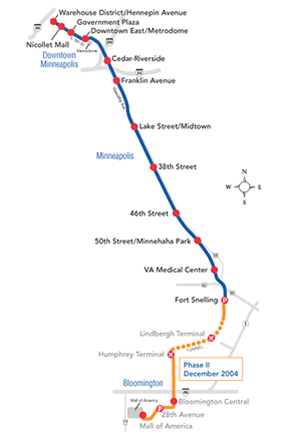 |
|
When completed, the Hiawatha light rail transit line
will stretch 11.6 miles from downtown Minneapolis to the Mall of America
in Bloomington. The first section of the line will open June 26; the final
section is expected to be done in December. Graphic courtesy of Metro
Transit
|
Crunch and the Timberwolves dance team, a mariachi band, an informal fashion
show, folkdance lessons and, of course, free train rides are all part of the
celebrations marking the opening of the Hiawatha light rail transit line in
Minneapolis on June 26.
Initially, trains will run between downtown Minneapolis and Fort Snelling,
stopping at 12 stations. Service to the Mall of America and the Minneapolis-St.
Paul International Airport is scheduled to begin in December. When the full
line is open, it will include 17 stations along its 11.6-mile route.
Festivities officially kickoff at 10 a.m. at the Warehouse District/Hennepin
Avenue Station, the line’s northern-most terminal. Following speeches from Gov.
Tim Pawlenty, Metropolitan Council Chair Peter Bell and others, the first of
the sleek yellow, black and silver trains will roll from the station.
All rides—on trains as well as Metro Transit buses—will be free to the public
on opening weekend.
From noon to 6 p.m. on Saturday, there will be celebrations at each of the
12 open stations. Members of the public will have the opportunity to hop on
and off the trains to experience the uniqueness of the neighborhoods in which
each station is located, including listening to live music, purchasing food
from local restaurants and taking tours of historic sites.
At the Downtown/East Metrodome Station, for example, there will opportunities
to get autographs from the Minnesota Twins players, receive a guided tour of
the Metrodome, listen to Boogie Wonderland, sample sports trivia and use batting
cages, among other activities.
For more information about the grand opening visit Metro
Transit Hiawatha Line.
Click here to view a history of Mn/DOT’s
LRT construction or use the links below to read articles that appeared in
Mn/DOT Newsline following construction progress, from relocating utilities
to groundbreaking to digging tunnels to testing the new rail cars:
- Early
backers of light rail transit get a preview ride on the Hiawatha line
(May 26, 2004)
- Workin’
on the LRT: building, testing roll on Hiawatha rail line (Oct. 15, 2003)
- First
Hiawatha Line LRT vehicle leaves Mexico for Minneapolis (March 5, 2003)
- Hiawatha
LRT-Korean Peace Garden wins award (Feb. 19, 2003)
- Hiawatha
LRT line moves toward completion (Dec. 11, 2002)
- Second
LRT tunnel completed beneath Minneapolis-St. Paul Airport (Nov. 6, 2002)
- Steady
progress brings Hiawatha LRT to halfway completion mark (Sept. 25, 2002)
- LRT
rails in downtown Minneapolis recall city’s first rail transit system
(July 17, 2002)
- LRT
southbound tunnel completed as digger sees sunlight after months underground
(May 1, 2002)
- Future
LRT station changes current map of downtown Minneapolis (March 6, 2002)
- Construction
of LRT line is on track (Nov. 7, 2001)
- Planes,
trains, ships and trucks: even "mechanical worms" travel multi-modally
(Aug. 15, 2001)
- First
LRT station groundbreaking attracts neighborhood advocates, government leaders
(Aug. 8, 2001)
- Judge
orders Xcel to move lines for Hiawatha light rail transit project (May
30, 2001)
- State,
Metropolitan Council file counterclaim against Xcel Energy (March 14,
2001)
|
back

|
 |
Hwy 169 in south metro receives ‘green light’ |
 |
 |
The first of 12 major highway projects marked for acceleration under the 2003
Pawlenty-Molnau transportation funding package began construction this week.
The intersection at Hwy 169 and Pioneer Trail in Bloomington and Eden Prairie
began construction on June 21, four years ahead of the original schedule.
The first step in the project is removing signal lights at the intersection,
which in effect will give motorists a "green light" on that portion
of the highway. Pioneer Trail will be closed between Hennepin Town Road and
Bloomington Ferry Road and local road detours will be posted.
The project includes constructing a bridge over Hwy 169, as well as constructing
retaining walls, noise walls and ponds. Some trees must be removed to accommodate
the road work, but many trees will be transplanted at various locations in the
community. Access to local businesses will remain available during construction.
The project is scheduled for completion in 2005.
Click here to read the Hwy
169 news release. Follow this link to learn more about the accelerated
projects.
Hwy 14 project to begin soon
The U.S. Army Corps of Engineers issued a wetlands permit to Mn/DOT on June
18, allowing the department to begin work on the Hwy 14 expansion project from
Janesville to Waseca. The project is one of 12 marked for acceleration under
the 2003 Pawlenty-Molnau transportation-funding package.
Work could begin before the end of June, according to the Mankato/District
7 office, which oversees the project.
Originally scheduled to start on May 3, the project was delayed so the Corps
of Engineers could hold a hearing and gather public input.
Mn/DOT is in the process of finalizing the contract for the project's
10 miles of four-lane expansion. Even with the eight-week delay, Mn/DOT
expects to complete this project in 2006 as originally scheduled.
Click here to read the Hwy
14 news release.
|
|
back

|
 |
Congressional delegation hears Mn/DOT’s priorities |
 |
 |
Mn/DOT staff, led by Deputy Commissioner Doug Differt and Jason Rohloff, Gov.
Pawlenty’s director of federal affairs, met in Washington D.C. with the state’s
congressional delegation to urge closure on the reauthorization bill for federal
transportation funding and federal issues that are of significance to Minnesota.
On the agenda was a request to correct the federal fiscal year 2004 Transportation
Appropriations Bill to prevent earmarked funds from being set aside from the
state’s share of the federal aid formula. According to Frank VanDeSteeg, Office
of Investment Management, if the correction is not made, Minnesota will lose
$14.6 million in regular federal funds, an error that could set back projects.
Mn/DOT staff also relayed the department’s strong support for the "ethanol
fix" in both the House and Senate versions of reauthorization bills for
federal funding.
"When we buy fuel that uses ethanol, which we do in Minnesota, a portion
of the fuel tax goes into the federal General Fund instead of into the Highway
Trust Fund," said Betsy Parker, director of government affairs.
"With the ethanol fix, all of the fuel tax paid at the pump would
be deposited into the Highway Trust Fund. That’s important because the formula
used to determine how much money each state gets under the federal transportation
authorization bill is based, in part, on how much fuel tax revenue that state
contributes to the Highway Trust Fund," she said.
According to Parker and VanDeSteeg, that change in how we tax and distribute
taxes on ethanol could result in an additional $50 to $70 million in federal
transportation funding for Minnesota.
Other issues raised included the "minimum guarantee" language of
the Senate that would guarantee a 95 percent rate of return on federal gas taxes;
toll road provisions that allow FAST lanes and tolling projects; the availability
of tax-exempt private facility bonds for public/private partnerships to construct
voluntary tolled lanes; and the expansion of State Infrastructure Banks.
According to VanDeSteeg, Mn/DOT missed out on the opportunity to use State
Infrastructure Banks under TEA-21, the last federal funding bill.
"SIBS are extremely useful for financing local projects through the creation
of revolving loan funds," he said. "Minnesota has such a revolving
loan fund law, but needs to be able to apply for federal funds to help finance
it."
For more information on these and other transportation issues, visit the Web
site of the American Association of State Highway and Transportation Officials
at http://transportation1.org/aashtonew/.
Posted prominently are reauthorization headlines – including a daily countdown
to expiration of the temporary TEA-21 extensions.
By Jeanne Aamodt
|
back

|
 |
Grand Excursion on Mississippi River to reenact 1854 event |
 |
 |
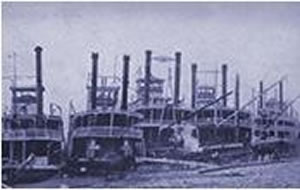 |
|
"Throw away your guide books; heed not the statement
of travelers; deal not with seekers after and retailers of the picturesque;
believe no man, but see for yourself the Mississippi River above Dubuque,"
the New York Times wrote in 1854. Photo courtesy of Grand Excursion
Web site
|
Steamboats, paddleboats, trains and bikes will voyage June 30-July 5 along
the Mississippi River from the Quad Cities in Illinois and Iowa to the Twin
Cities as part of the 150th anniversary of the state’s first Grand Excursion.
In 1854, after the arrival of the first railroad to the Mississippi, 1,200
statesmen, historians, diplomats, poets and journalists traveled by steamboat
from Illinois to St. Paul to check out the beauty, resources and investment
potential of the "western frontier." Resulting newspaper stories attracted
thousands of settlers to the area and soon Minnesota became a state.
This year, more than 60,000 passengers and almost as many visitors from around
the world are expected to take part in community celebrations in Minnesota,
including theatrical performances, museum exhibits and tours. Some celebrations
involve dedication of legacy projects—gifts to future generations—that include
parks, trails, river clean-ups, historic renovations and public art.
Lt. Gov./Transportation Commissioner Carol Molnau will attend a Grand Excursion
celebration and dedication of the National Eagle Center in Wabasha July 1. She
and Gov. Tim Pawlenty will take part in events to welcome the river flotilla
and train arrivals in St. Paul on July 3.
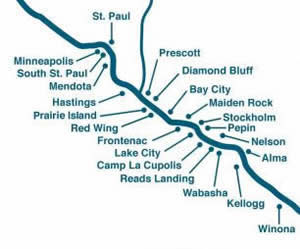 |
|
More than 100,000 people are expected to take part
in community celebrations along the Mississippi River June 30-July 5 as
part of the 150th anniversary of the state’s first Grand Excursion.
Graphic courtesy of Grand Excursion Web site
|
"Grand Excursion is a celebration of transportation and how railroads,
waterways, roadways and trails all came together to shape our state and our
economy," Molnau said. "It also draws attention to the importance
of balancing transportation needs with environmental considerations on and along
Minnesota rivers."
Visit the Grand Excursion Web site at www.grandexcursion.com
for information about events and how to get there. For celebrations along the
river, follow the Highway 61 Great River Road, official scenic byway of the
Grand Excursion; check out the route at www.mnmississippiriver.com.
Before heading out to Grand Excursion events, especially over the July 4 weekend,
get advance traveler information by calling 511 or visit the Web at 511mn.org.
Also, because of the possibility of high water and swift currents, boaters
are advised to use caution and wear a personal floatation device when operating
a boat on the river during Grand Excursion festivities.
By Donna Lindberg
|
back

|
 |
Workshop participants identify best practices for improving, accelerating construction
projects |
 |
 |
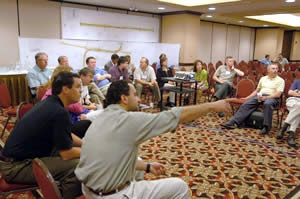 |
|
(Foreground) Amr Jabr, Metro Traffic engineer, gives
his opinion on how to enhance safety and improve traffic management through
the Crosstown Commons. Photo by Dave Gonzalez
|
Mn/DOT was host to 100 transportation experts, who met recently to understand
the complexities of the I-35W/Hwy 62 Crosstown project and to make recommendations
on innovative ways to construct the project faster, better and safer.
The Federal Highway Association and the American Association of State Highway
and Transportation Officials sponsored the Accelerated Construction Technology
Transfer Workshop, held June 14-16 at the Crowne Plaza Hotel in Minneapolis.
"This is only the eighth national workshop held, and Minnesota is extremely
fortunate to have been chosen," said Terry Zoller, Metro construction engineer
and workshop coordinator. "Reconstruction of the I-35W/Hwy 62 Commons is
a complicated project that hasn’t been without conflict, and the collective
problem-solving on this project couldn’t be timelier as construction starts
in 2006."
ACTT is a strategic process that identifies innovative techniques, strategies
and technologies to reduce actual construction time on large, complex multiphase
highway construction projects. The workshop brings experts with specific skills
sets together for an intense three days to identify "best practices"
that could be incorporated into an existing construction project in order to
dramatically save money, improve safety and quality while minimizing the delays
and hazards associated with work zones.
FHWA and AASHTO believe transportation departments can greatly increase a project’s
success when all skill sets are incorporated from planning to actual delivery.
The Minnesota workshop included experts from right-of-way/utilities, structures,
innovative contracting, materials, construction, environment, traffic, intelligent
transportation systems, safety and public relations.
Participants and observers represented several states, FHWA, consulting and
construction companies, Minnehaha Creek Watershed District, Minnesota Pollution
Control Agency, cities of Minneapolis and Richfield, and Mn/DOT staff.
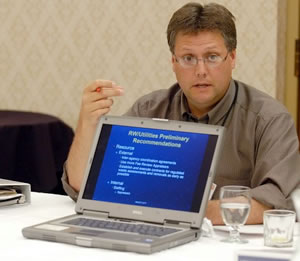 |
|
Joe Pignato, a supervisor in the Office of Land Management,
was one of the presenters at the Accelerated Construction Technology Transfer
Workshop, held June 14-16 in Minneapolis. Photo by Dave Gonzalez
|
Lt. Gov. Carol Molnau welcomed participants to the workshop.
"You are all too familiar with the major challenges facing highway construction:
an aging infrastructure, limited funds and increased traffic causing high levels
of congestion," Molnau said. "Minnesota is not a stranger to those
mounting challenges, and the Crosstown project is a perfect example.
"Minnesota motorists will reap the benefits of your hard work over the
next three days and on their behalf I thank you for your recommendations for
accelerating this major project," she said.
Tom O’Keefe, West Metro area manager, and John Griffith, area engineer and
Crosstown Commons project manager, presented a project overview and hosted bus
tours so workshop participants could experience driving through the Crosstown
Commons during the evening rush hour.
"We are anxious to review all the recommendations and will be evaluating
which ideas, technologies and products are practical and feasible to be used
on this project," said O’Keefe.
Griffith added, "This is an unbelievable opportunity to hear what’s working
in other states to minimize construction closures, add road capacity and use
state-of-the-art technology not only on this project but, I expect, on many
other Mn/DOT construction projects."
The existing roadway carries approximately 155,000 cars in the commons section
in Minneapolis and Richfield and more than 225,000 when all of the interchange
movements are considered. Two and a half years ago, Mn/DOT was ready to begin
the reconstruction of I-35W, including the Crosstown Commons Interchange, when
the Legislature put a moratorium on the project. The current project is scheduled
for contract letting in Spring 2006 with construction completion in 2010. Current
funding is $208 million in 2005 dollars.
Visit http://projects.dot.state.mn.us/crosstown
for more information about the project.
By Judy C. Melander, Metro District communications director
|
back

|
 |
Nuclear power drill helps agencies prepare for potential disasters |
 |
 |
Mn/DOT received high marks from the Federal Emergency Management Agency for
its part in a drill the State Emergency Operations Center conducted June 16
for the Prairie Island nuclear power plant.
"It’s important to have that formal feedback, which helps us identify
the areas that need improvement," said Sonia Pitt, director of Mn/DOT’s
Homeland Security. "We want to be ready when and if an event should happen."
The Prairie Island plant is one of two nuclear power facilities in Minnesota
and is considered a vulnerable target for natural and technological disasters
since it has a potential to release radioactive materials. Each year a response
drill and subsequent exercises are carried out for one of the two plants to
test Mn/DOT’s and other state agencies’ ability to respond to a major event.
"These drills, which contain scenarios involving terrorist attacks, fires
or floods, help us assess our readiness to address incidents involving the plants,
and it helps us recognize the effectiveness of our procedures and plans,"
said Bob Vasek, Mn/DOT’s emergency response coordinator.
The drills and exercises are usually not full-scale, requiring mobilization
of field staff and equipment.
However, emergency coordinators must respond as if there was a real-life incident
occurring. For this reason Vasek relies on what is called a "call-out"
list to contact or alert the operations and communications team to carry out
a certain action. Contacts consist of public information officers, area maintenance
superintendents, hazardous materials team representatives, safety officers and
district maintenance and traffic engineers.
"Mn/DOT, along with State Patrol and other state and local agencies, have
the responsibility for evacuation routes, traffic control and debris removal
to maintain an orderly traffic flow away from these plants in the event of an
emergency," Vasek said. "For this to be successful and safe for the
public and those helping with a potential evacuation, a plan and call list must
be maintained."
The Division of Emergency Management coordinates these drills as the state’s
lead team for the Department of Public Safety.
By Daneeka Marshall-Oquendo
|
back

|
 |
Groundbreaking heralds new Hwy 371 welcome center near Brainerd |
 |
 |
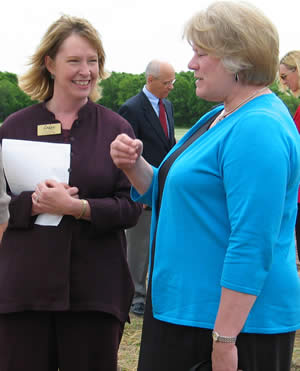 |
|
Lisa Paxton, director of the Brainerd Lakes Chambers
of Commerce, meets with Lt. Gov. Carol Molnau at the June 16 groundbreaking
near Brainerd. Photo by Jenny Seelen
|
Lt. Gov/Commissioner Carol Molnau joined leaders from Crow Wing County, the
Department of Natural Resources, the State Patrol and the Brainerd Lakes Area
Chambers of Commerce to shovel ceremonial clods of dirt at a groundbreaking
ceremony June 16 for the new Brainerd Lakes Area Welcome Center on Hwy 371.
Construction of the $1.3-million center will begin this summer. The new facility
will be built on Hwy 371 about five miles south of Brainerd on the site of Mn/DOT’s
Hwy 371 Safety Rest Area.
The groundbreaking capped a 10-year effort to create the welcome center. Those
efforts include special legislation to authorize joint operation by state agencies
and a private entity.
Molnau said the center represents a unique public-private partnership that
will allow state agencies and the area chambers of commerce to operate the facility
jointly and share its construction and operating costs.
The area chambers will staff the travel information counter. Mn/DOT will operate
and maintain the rest area part of the new facility.
The building will also include offices for the State Patrol and display space
for the DNR.
When the center is completed, visitors will find a floor-sized map of the Brainerd
lakes region; a putting green to help them unwind after a long trip; a picnic
area; new statues of the legendary Paul Bunyan and Babe the Blue Ox; a gift
shop, and high-speed Internet access.
Molnau said the center’s funding and operation exemplifies innovation under
way in state government to cut costs to taxpayers while expanding customer-focused
services.
"The Hwy 371 welcome center is a terrific model that will provide government
services more efficiently and, thanks to the additional authority provided by
the 2004 Legislature, Mn/DOT will be able to forge similar partnerships with
other chambers of commerce and communities across the state," she said.
By Craig Wilkins
|
back

|
 |
Site dedicated for new multi-jurisdictional building at Thief River Falls |
 |
 |
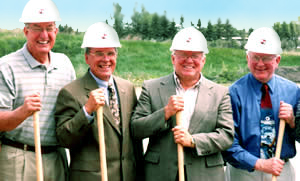 |
|
Wes Gjovik (second from right) joins groundbreaking
ceremonies with (from left) State Sen. LeRoy Stumpf, Thief River Falls;
Richard Post, facilities director, Metro District; Thief River Falls Mayor
Dale Wennberg, and Bob Carlson, chair, Pennington County Board of Commissioners.
Photo by Karen Bedeau
|
This time next year, the Pennington County Public Works facility in Thief River
Falls will have new neighbors—people from the State Patrol and Driver and Vehicle
Services, the Department of Natural Resources and Mn/DOT.
The new faces will work in a building now under construction adjacent to the
county building the agencies will share to save costs and improve the effectiveness
of the services they provide.
Groundbreaking ceremonies for the new building were held at the site on County
Road 16 on June 9.
The new structure will house Bemidji/District 2’s maintenance and radio shops
and its construction resident office. The building will also provide space for
a regional office of the State Patrol as well as regional DNR offices for enforcement
and trails, waterways and wildlife management functions.
The shared facilities enable staff from each agency to exchange knowledge and
expertise of mutual benefit as well as reduce construction and operational costs.
Karen Bedeau, Bemidji district public affairs coordinator, said the project
was first conceived about 20 years ago.
The one-story building will contain 63,000 square feet for shops, offices and
vehicle storage. Cost of the structure is about $6 million.
Dick Post, the Metro District’s facilities program director, said the new building
will exceed energy sustainability guidelines due to its concrete block structure,
rigid insulation thickness and site location designed to maximize solar exposure.
The building, he said, will include a large glassed-in entrance area to provide
solar heat and natural light.
The new building will become one of several such facilities shared by Mn/DOT
and other government agencies throughout the state. The first, the Hutchinson
Area Transportation Services facility, was completed in 1996.
The new facility helps cap the career of Wes Gjovik, Bemidji district engineer,
who will retire in July.
Gjovik, who worked at the old TRF resident office twice in his Mn/DOT career,
said he and others started thinking about a new facility about 20 years ago.
"It’s taken a while, but it’s worth it," Gjovik said. "With
the new facility, people can share equipment and ideas, increase cooperation
and deal with each other face-to-face."
By Craig Wilkins
|
back

|
 |
Quick bridge deck removal gets traffic moving again on busy I-94 |
 |
 |
Under promise; over deliver.
With cooperation from the weather, Metro District crews and contractors’ employees
did just that in Minneapolis on the weekend of June 12-13.
They removed the deteriorated concrete deck from the I-94/Riverside Avenue
bridge in Minneapolis in about 40 hours, reducing the amount of time the busy
freeway (157,000 average daily traffic) was detoured by nearly a full day.
Steve Adamsky, project manager, Metro District, said the westbound lanes were
closed at 10 p.m.; the eastbound lanes stayed open until 11 p.m. because of
a Twins baseball game.
Adamsky said good weather, an experienced crew and three huge backhoes that
pounded tons of concrete and rebar loose allowed the deck to be removed quickly
without incident or delay.
Originally scheduled to re-open at 5:30 a.m. on June 14, the westbound lanes
re-opened instead by 3:30 p.m. on June 13 after crews removed the deck, cleared
away tons of concrete and rebar, and removed detour signs. A few hours later
and the eastbound lanes were open again as well.
The crews worked around the clock to complete the project and to re-open the
freeway.
The Metro District detoured freeway traffic to reduce the possibility of mishaps
involving motorists and to give work crews unhampered access to the bridge.
Adamsky said replacing the deck will take about 60 days.
By Craig Wilkins
|
back

|
 |
District newsletters add local color to department news coverage |
 |
 |
There’s a smorgasbord of information for employees wanting to know what’s happening
around the department, and one way to sample what’s out there is to read Mn/DOT
Newsline and the district employee newsletters regularly.
The purpose of Mn/DOT Newsline is to cover news and events of interest
to all employees statewide. District newsletters are intended to supplement
Mn/DOT Newsline with local stories and events of interest to a particular
district’s employees.
For example, a recent issue of the Metro
District newsletter featured articles on Doug Thies, the district's new
safety administrator, and the creation of a new training-meeting room in the
Waters Edge building in Roseville. Editor: R. Kent Barnard, 651/582-1364
In Willmar/District
8, the employee newsletter included an article about the district’s Emergency
Action Plan and what to do if a tornado threatens the area. Editor: Diane
Beck, 320/214-3681
The Mankato/District
7 newsletter recently reported on how the coordination and cooperation on
the Hwy 14 New Ulm reconstruction project resulted in a positive editorial in
the New Ulm Journal. Editors: Rebecca Arndt (Mankato), 507/389-6883; Anita
Perrizo (Windom), 507/831-1207
In Rochester/District
6, the newsletter highlighted the district employee days and the 2004 construction
season. Editor: Brian Jergenson, 507/285-7364
Recent newsletters from Brainerd/District
3 showcased employees and their dads and the Materials Lab staff who, during
the post-construction season, teach four technical certification classes to
Mn/DOT employees and public/private partners. Editor: Cathy Clark, 218/828-2464;
Web & graphics design: Jenny Seelen, 218/828-6018
And in Bemidji/District
2, the newsletter paid tribute to Bill Frost, a 40-year Mn/DOT employee
who died in January 2004, and featured pavement and bridge construction awards
the districts recently received. Editor: Karen Bedeau, 218/755-4086
Duluth/District 1 currently does not have an employee newsletter.
You can easily access the district newsletters from navigation bars located
on Mn/DOT Newsline and http://iHUB or by clicking
on the links provided above.
As always, you can find additional news about the employee marriages, births,
retirements, funerals as well as other announcements in Employeeline,
the personal side of Mn/DOT Newsline.
|
back

|
 |
Online service offers transportation news du jour |
 |
 |
 |
|
Mn/DOT's online news clipping service provides access
to hundreds of articles about transportation and the department that have
appeared in online news media.
|
If you haven’t read the New Ulm Journal or the Minneapolis Skyway
News lately, chances are you missed coverage of the
mud slides that closed Hwy 169 in southern Minnesota and information about
art for the light-rail
transit stations along the Hiawatha corridor in south Minneapolis.
Not to worry. You can look up these articles—and hundreds of others—using the
department’s online news site. Mn/DOT subscribes to a service that gathers transportation
and department-related articles from state and national online news media. Office
of Communications staff then daily weed through dozens of articles and post
the most pertinent ones to Mn/DOT’s internal Web page (iHUB).
Features of Mn/DOT’s daily news clipping site include:
-
A "go to today's clippings" button that will bring up the most recent clippings
-
A news archive that provides access to clippings for any date starting
with February 2001
-
A search engine that can look for news articles on specific topics
To view the news clippings, go to http://ihub/
and select "Daily News Clippings."
|
back

|
 |
|
 |



